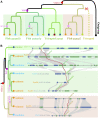Evolutionary Genomics Reveals Multiple Functions of Arylalkylamine N-Acetyltransferase in Fish
- PMID: 35664299
- PMCID: PMC9160868
- DOI: 10.3389/fgene.2022.820442
Evolutionary Genomics Reveals Multiple Functions of Arylalkylamine N-Acetyltransferase in Fish
Abstract
As an important hormone, melatonin participates in endocrine regulation of diverse functions in vertebrates. Its biosynthesis is catalyzed by four cascaded enzymes, among them, arylalkylamine N-acetyltransferase (AANAT) is the most critical one. Although only single aanat gene has been identified in most groups of vertebrates, researchers including us have determined that fish have the most diverse of aanat genes (aanat1a, aanat1b, and aanat2), playing various potential roles such as seasonal migration, amphibious aerial vision, and cave or deep-sea adaptation. With the rapid development of genome and transcriptome sequencing, more and more putative sequences of fish aanat genes are going to be available. Related phylogeny and functional investigations will enrich our understanding of AANAT functions in various fish species.
Keywords: arylalkylamine N-acetyltransferase (AANAT); fish; melatonin biosynthesis; phylogeny; physiological function.
Copyright © 2022 Huang, Li, Bian, Li, You and Shi.
Conflict of interest statement
The authors YH, CB, RL, XY, and QS were employed by BGI Academy of Marine Sciences. The remaining author declares that the research was conducted in the absence of any commercial or financial relationships that could be construed as a potential conflict of interest.
Figures







References
-
- Aripin S. A., Jintasataporn O., Yoonpundh R. (2015). Effects of Exogenous Melatonin in Clarias Macrocephalus Male Broodstock First Puberty Stage. J. Aquac. Res. Develop. 6, 307. 10.4172/2155-9546.1000307 - DOI
-
- Badruzzaman M., Ikegami T., Amin A. K. M. R., Shahjahan M. (2020). Melatonin Inhibits Reproductive Activity through Changes of Serotonergic Activity in the Brain of Freshwater Catfish (Mystus Cavasius). Aquaculture 526, 735378. 10.1016/j.aquaculture.2020.735378 - DOI
-
- Berthelot C., Brunet F., Chalopin D., Juanchich A., Bernard M., Noël B., Bento P., Da Silva C., Labadie K., Alberti A., Aury J.-M., Louis (2014). The Rainbow trout Genome Provides Novel Insights into Evolution after Whole-Genome Duplication in Vertebrates. Nat. Commun. 5, 3657. 10.1038/ncomms4657 - DOI - PMC - PubMed
Publication types
LinkOut - more resources
Full Text Sources
Research Materials

